Spain’s Lady of Elche Unveils New Connections to an Indian Deity

Many of us have heard of the famous Lady of Elche and are intrigued with her mystifying appearance, and the strange enigma surrounding her origins. In reality not a whole lot is known about the bust of this grand lady.

Lady of Elche artifact in Spain. (Provided by the author)
Is the Lady of Elche Really Carthage’s Deity Tanit?
However, some things we know are that she was found in 1897 on a private estate, which is now an archaeological site called La Alucidia, and this site is located a few miles south of Elche, Spain. The artifact is thought to be Punic-Iberian, and is delicately carved out of limestone. It may have once been a full- bodied sculpture, and is possibly dated to the 4th century BC. Some speculate that she is an embodiment of the ancient Carthaginian deity known as Tanit.
Carthage itself was founded by the Phoenicians in approximately 814 BC. Tanit was a Phoenician and Punic goddess. She and her consort Baal-Hamon were the most important deities in Carthage. It seems that Tanit was known as a virginal goddess, a heavenly goddess of war, and to a lesser extent, she was also worshiped as a deity of fertility, as most female forms tend to be.

Ancient Carthaginian deity Tanit, Ibiza. (Provided by the author)
Unfortunately, there is some disheartening evidence from the research of ancient tophets located in ancient Carthage, which shows that sacrifice’s may have been practiced as a ritualistic offering to both Tanit and her consort. The research on the topic of what type of sacrifices were offered to the deity is highly controversial, and it is not factually possible to say for certain what kind of sacrifices took place.
Inspiration Found in the Museum of Paris
While traveling to Paris, France a few days back I visited the Louvre Museum for the third time, which houses some fantastic artifacts, and although it was my third trip, I was still not able to see all the objects as the museum is huge. I also was advised to visit the Guimet National Museum of Asian Arts in order to peruse all the magnificent and majestic artifacts with the promise that the museum would not disappoint, and it did not! I saw some amazing and unexpected pieces.
As I happily scanned the museum, I saw so many items that were impressive, but in particular my eyes were drawn to an enchanting object from the Chandraketurgah archaeological site in West Bengal, India. More specifically, the Chandraketurgah site is located about 50 kilometers (31 mi) northeast of Kolkata (Calcutta).
The Chandraketugarh site that the artifact arose from is very interesting, and was called Gandaridae by Greco-Roman authors, and is dated to possibly as far back as the 4th or 5th century BC though most likely the site is even older. The Greek writer and geographer Ptolemy mention’s the site in his book the Geographia circa 150 ad, and other famous writers of the past also penned information about Chandraketugarh including Plutarch and Diodorus.
In fact, Diodorus wrote that no foreign force had ever conquered Gandaridae (Chandraketugarh), because of its strong elephant regime. He even described how Alexander the Great hastily fled from battle after hearing of the 4,000 strong elephant army he would have to face.

Chandraketugarh elephant artifact, West Bengal, India. (Provided by the author)
The item in the museum display case, which had captured my attention so thoroughly was a small terracotta plaque, and though small it gave a very big impression. It was a beautiful piece having the usual light orangey fired-earth color, but the design was quite the opposite. It was of a very unusual style, yet it was still easily recognizable as having been produced in the ancient Indian way, which often depicts voluptuous and curvy women wearing intricate clothing and jewelry designs.

Chandraketugarh artifact West Bengal, India. (Provided by the author)
The stunning yet mysterious Lady of Elche
Meenakshi: The Warrior Goddess Who Could Not Be Defeated by Any Man …Until She Met Shiva
Goddess… or Demon? Hidden History of Vinayaki, the Mysterious Elephant-Headed Woman of Hindu Myth
Links with Indian Goddess
As I researched the Chandraketugarh artifact even more thoroughly, I discovered that the piece was not an anomaly, but is one of many known as the ‘Ladies with Weapons as Hairpins’ Indian goddesses, and also described as ‘Ladies with Auspicious Hairpins’ by Bijan Mondal, UGC Senior Research Fellow Department of Archaeology at the University of Calcutta.

Examples of ‘Ladies with Weapons as Hairpins’/ Indian Goddess artifacts. (Provided by the author)
After examining the Chandraketugarh artifact in detail I noted how very closely it resembled the engaging bust of the Lady of Elche! Both artifacts have ‘wheels’ on the sides of their heads, sport spiked ‘headbands’, and display beautiful jewelry hanging from the ear regions. As you see, the pair are also wearing beautiful necklaces. The fact that both artifacts seem to have so much in common would be quite baffling unless they were portraying the same type of goddess figure, which I firmly believe to be the case in this instance.

The Indian goddess artifact from Chandraketugarh (left) and Lady of Elche artifact (right). (Provided by the author)
Since the unusual bicornate headgear contains weapons, it effectively cements the view that the deity is portrayed as one that could invoke tremendous power if she so wished. This was no pushover Indian goddess, but one of war. One that may have given even Alexander the Great a run for his money at Chandraketugarh!
Too Much to be a Coincidence
We may speculate that these two feminine deities skillfully depicted at the La Alucidia site in Spain, and the Chandraketugarh site in India must have some specific ancient relationship to one another, as the complex set of symbols and designs shown on both artifacts statistically could not be simple coincidence.
If we look even closer at the detail of the Chandraketugarh ‘Lady’ we will note some unusual, but distinct markings that may help us to further conjecture that she is indeed related to the ancient deity Tanit. On the forehead of the artifact is a clear-cut indication of an intended stylized crescent moon, which is a symbol associated with Tanit.

Collage showing comparison of the crescent moon on forehead of the Indian goddess and the symbol associated with Tanit. (Provided by the author)
Fertile Femme Fatales
If the Lady of Elche is a depiction of Tanit, which evidence indicates, then we know that the Lady of Elche would have also had a visage linked to war and violence. Most likely she would have been relegated some sort of sacrificial offerings as well. Also, the lady would have been related to fertility and regeneration of life, just as Tanit was.
With that information, we can then propose another link between the Lady of Elche and the ‘The Lady with Weapons as Hairpins’, as they both not only wear almost the exact same headgear, but both are deities of war, weaponry and brutality. Thus, they are deities related to death in some form or another. Last but not least they are both connected to fertility just like Tanit is. The fertility aspect is easy to spot on the Chandraketugarh artifact, and is prominently displayed by the beautiful blooming flower designs attached to her head-wear.

Fertile Femme Fatales. Left is Tanit, middle is the Indian goddess from Chandraketugarh and right the Lady of Elche, showing the similarity with all deities. (Provided by the author)
We mustn’t forget that after the fire, new maps are drawn! When all the demise and destruction subside, no doubt the Fertile Femme Fatales will then begin the rejuvenation, regeneration, and renewal cycles anew… just as they always have.